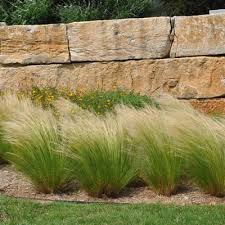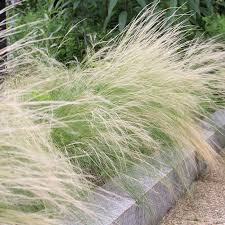Nassella Tenuissima Grass, also known as Mexican Feathergrass, is a delicate and graceful plant that adds a touch of beauty to gardens and landscapes. This ornamental grass is native to North America and Mexico. Its slender, fine-textured leaves sway gently in the breeze, resembling soft feathers.
Mexican Feathergrass grows in clumps, reaching a height of about 1 to 2 feet. Its slender stems bear fluffy flower heads that appear in late spring to early summer. These flower heads start as green and turn golden as they mature, creating a stunning contrast against the green foliage.
One of the remarkable features of Nassella Tenuissima is its adaptability. It thrives in various soil types and can tolerate drought conditions, making it a popular choice for low-maintenance gardens. However, it’s important to note that this grass can self-seed prolifically, potentially becoming invasive in some regions.
Gardeners often use Mexican Feathergrass to add a touch of movement and elegance to their landscapes. It looks fantastic when planted in mass groupings or used as an accent plant in rock gardens. Its fine texture complements other plants and provides a sense of airiness to the overall design.
However, Nassella Tenuissima Grass, or Mexican Feathergrass, is a beautiful and versatile ornamental grass that brings a sense of grace and movement to gardens. Its slender leaves and golden flower heads make it a charming addition, while its adaptability and low-maintenance nature make it a favored choice for landscaping projects.
Read Also: Concrete Pond Management: Steps to take before introducing the Fish in the Water
Growing Nassella Tenuissima Grass

Here’s a simple growing guide for Nassella Tenuissima Grass (Mexican Feathergrass):
1. Location: Choose a sunny spot in your garden or landscape. Mexican Feathergrass prefers full sun, which means it needs at least 6 hours of direct sunlight each day.
2. Soil: This grass is adaptable to a variety of soil types, but it prefers well-draining soil. Make sure the soil isn’t overly compacted, as good drainage is essential for the health of the plant.
3. Planting: Plant Mexican Feathergrass in spring or early fall. Dig a hole that is slightly larger than the root ball of the plant. Place the plant in the hole at the same depth it was in its container. Backfill the hole with soil and gently pat it down.
4. Spacing: Space the plants about 1 to 2 feet apart to allow them room to grow and spread.
5. Watering: Water the newly planted grass regularly for the first few weeks to help establish its roots. After that, Mexican Feathergrass is drought-tolerant and requires minimal watering. Water it during prolonged dry periods.
6. Mulching: Apply a layer of mulch around the base of the plants to help retain soil moisture and control weed growth.
7. Pruning: In late winter or early spring, you can trim back the dead or damaged growth to encourage new growth for the upcoming season.
8. Fertilizing: Mexican Feathergrass generally doesn’t require heavy fertilization. A light application of a balanced, slow-release fertilizer in spring can be beneficial.
9. Self-Seeding: Be aware that Mexican Feathergrass is a prolific self-seeder. If you want to prevent it from spreading too much, consider deadheading (removing the spent flowers) before they have a chance to produce seeds.
10. Pests and Diseases: This grass is relatively resistant to pests and diseases. However, keeping the area around the plants clean and free from debris can help prevent potential issues.
11. Invasive Concerns: In some regions, Mexican Feathergrass has become invasive. Check with local authorities or gardening experts to ensure it’s safe to plant in your area.
Remember, while Mexican Feathergrass is low-maintenance, it’s important to keep an eye on its growth and behavior, especially in terms of self-seeding. Regular maintenance and proper care will help you enjoy the beauty of this graceful grass in your garden.
Caring for Nassella Tenuissima Grass
Here’s a simple caring guide for Nassella Tenuissima Grass (Mexican Feathergrass):
1. Watering: Once established, Mexican Feathergrass is drought-tolerant and requires minimal watering. Water deeply and infrequently, allowing the soil to dry out between waterings. Overwatering can lead to root rot, so it’s better to err on the side of underwatering.
2. Mulching: Apply a layer of organic mulch around the base of the plants to help retain soil moisture and regulate temperature. This is especially important during hot summer months.
3. Pruning: In late winter or early spring, trim back the dead or damaged growth. This encourages new growth and helps maintain the plant’s neat appearance.
4. Fertilizing: Mexican Feathergrass doesn’t require heavy fertilization. In fact, excessive fertilizing can cause it to become overly lush and floppy. A light application of a balanced, slow-release fertilizer in spring is sufficient.
5. Dividing: Over time, Mexican Feathergrass can form clumps that become too large or crowded. To maintain healthy growth, consider dividing the clumps every few years in early spring. Dig up the clump, separate it into smaller sections, and replant them.
6. Self-Seeding Management: If you want to control the spread of Mexican Feathergrass, consider removing the spent flower heads before they produce seeds. This can prevent the plant from self-seeding too aggressively and potentially becoming invasive.
7. Pest and Disease Management: This grass is relatively pest and disease resistant. However, keep an eye out for any signs of pests or diseases, such as discoloration or damage to the leaves. Treat any issues promptly with appropriate measures.
8. Winter Care: Mexican Feathergrass is generally hardy, but in colder climates, the foliage may turn brown during the winter months. Leaving the brown foliage in place can help protect the plant’s crown from extreme cold. Trim back the dead growth in early spring before new growth emerges.
9. Invasive Potential: In areas where Mexican Feathergrass is considered invasive, take extra care to prevent its spread. Remove any seedlings that appear in unwanted areas and consider alternative plants if necessary.
10. Monitoring: Regularly observe the plant for changes in growth, appearance, or behavior. Adjust your care routine as needed based on the specific conditions in your garden.
Remember that Mexican Feathergrass’s charm lies in its natural, graceful appearance. Avoid over-manicuring or excessive care, as it thrives when given a bit of room to sway and move in the breeze. Following these care tips will help you enjoy the beauty of this lovely ornamental grass while keeping it healthy and vibrant.
Read Also: Earthen Pond Management: Steps to take before putting the Fish in the Water
Benefits of Nassella Tenuissima Grass

Here are some benefits of growing Nassella Tenuissima Grass (Mexican Feathergrass):
1. Low Maintenance: This grass is known for its low-maintenance requirements. It’s drought-tolerant and doesn’t need frequent watering once established. This makes it an excellent choice for water-conscious or busy gardeners.
2. Adaptability: Mexican Feathergrass is adaptable to various soil types and growing conditions. It can thrive in different climates and is suitable for both formal and informal garden designs.
3. Wildlife Attraction: The grass’s airy flower heads provide shelter and nesting material for birds and insects. It contributes to a healthier ecosystem by attracting pollinators and other beneficial wildlife.
4. Erosion Control: The fibrous root system of Mexican Feathergrass helps stabilize soil and prevent erosion on slopes or in areas prone to runoff.
5. Natural Screening: When planted in groups, Mexican Feathergrass can create a gentle screen that adds privacy without completely blocking views. It offers a sense of separation without feeling heavy or intrusive.
6. Rock Gardens: Its fine texture and graceful movement make Mexican Feathergrass a popular choice for rock gardens, adding a sense of movement and contrast among the rocks.
7. Versatility: This grass can be used as a standalone specimen plant, in mass plantings, or as an accent in mixed borders. Its versatility makes it easy to incorporate into various landscape designs.
8. Long-Lasting Interest: Even after the growing season, the dried flower heads of Mexican Feathergrass can provide winter interest in the garden. They sway in the wind and catch the sunlight, adding a touch of beauty to the winter landscape.
9. Sustainable Landscaping: Due to its ability to thrive with minimal water and care, Mexican Feathergrass aligns with sustainable landscaping practices that conserve resources and reduce environmental impact.
10. Educational Value: Growing Mexican Feathergrass can provide opportunities for educational experiences, as gardeners learn about its growth habits, life cycle, and the importance of balanced ecosystems.
11. Cultural Significance: In addition to its practical benefits, Mexican Feathergrass holds cultural significance in some regions and can be used in landscaping to honor or connect with local traditions.
Overall, Nassella Tenuissima Grass offers a range of benefits, from its aesthetic contributions to the garden to its role in supporting local wildlife and promoting sustainable landscaping practices.
Read Also: A Comprehensive Guide to Recycling Benefits
